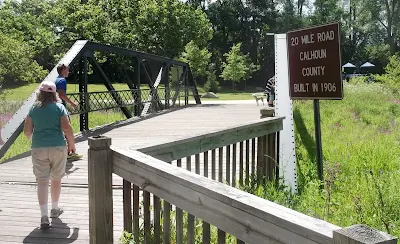"Being grateful" is not the usual reaction to food poisoning.
But I am grateful that the piece of chicken was very thoroughly microwaved. I think that all of the pathogens were dead and I only had to deal with the toxins.
I am grateful that I spit out the first (and only) mouthful because it tasted "off".
In retrospect, I wish I had thoroughly rinsed out my mouth instead of just spitting.
I am grateful for the timing. All of the purging was done before our Friday day trip. I was still cramping. My body still wanted to get rid of every vestige of the toxins. But there was nothing left to push out.
I am grateful for the long shelf life of Loperamide (aka, Imodium). The blister pack in our medicine locker had expired 18 months ago but it still worked. There is much to be said for storing meds under favorable conditions, that is, cool, dark and dry.
I am grateful that we got to spend some time with Mrs ERJ's second cousin. Mike is a retired Civil Engineer. He used to work for the Michigan Department of Transportation and he was responsible for inspecting highway bridges. Consequently, he knew about "Historic Bridge Park". This little county park in Calhoun County (Michigan) is sort of a retirement home for old wrought iron and steel bridges.
Mike was our tour guide and he was personally invested in this park because several of the bridges were "retired" on his watch. In many cases, the bridge was not retired for safety reasons but because they were either not wide enough to meet current standards or because they were too flexible....drivers were not comfortable with the amount of creaking and sag-and-sway they experienced while driving across them.
 |
| These bridges all span a trout stream. It was a beautiful day. The Purple Loosestrife and Queen Anne's Lace are at peak bloom. |
Sidenote: According to Mike, modern bridges are designed to be highly redundant and structurally indeterminate. That means that a truck can plow into an abutment and the bridge will, most likely, remain standing such that vehicles on the upper span can safely clear the span. Of course, the bridge is likely to be declared unfit for use until repaired....but it will, probably, not come crashing down.
| If you do an image search for "truck stuck under bridge" you will notice that most of the bridges that are pictured are railroad bridges. Image from HERE |
Another trend in bridges was to get away from above-roadbed trusses. Putting the support structure beneath the roadbed reduced the likelihood of drivers hitting it. Of course, some drivers will still try as shown in the video shown above.
Cousin Mike was a fabulous host. He pointed out little details like head-stamps on bolts (see, I meant nuts-and-bolts literally!) and the shape of weld beads and was able to estimate when various maintenance work had been done on these bridges. He also treated us to a delicious picnic lunch.
Engineers
As a Mechanical Engineer it was necessary for me to give him a little bit of grief. Our pet name for Civil Engineers is "Target" Engineers. He was very good-natured about the ribbing.
He reminded me that Civil Engineers have saved more lives than all of the Doctors in history by virtue of the design of sewerage and waste water treatment plants. Then he shared a pretty cool idea he had: Why don't waste water treatment plants capture the methane generated by the anaerobic processes and use that methane to power gas-turbine/generators to make the plant self powering?
Mike's primary motive was not economic but to armor the waste water plants against power interruptions. Weather events that cause power interruptions often dump a lot of water that would challenge the plant even if the power stayed on. He sees it as a public health and an environmental health issue. And even if the plant does not produce enough methane to power a turbine it could be supplemented by natural gas. The NG pipeline system is not dependent on the local power grid to maintain pressure.
He noted that people near waste water plants sometimes complain about the smell. That smell is methane gas. The observations that "A weed is a perfectly good plant growing in the wrong place." and "A problem is simply a misplaced or under utilized resource." are still true. It was neat to see how Mike's mind works.
He is a sharp guy. I am grateful that he invited us to visit "his" park.



This comment has been removed by the author.
ReplyDeleteCousin Mike is correct... we take effective wastewater treatment - and safe drinking water for granted here... wasn't always the case, and still is not the case in much of the world.
ReplyDeleteI took a 'Sanitary Microbiology' course, back in the late 1970s - classroom was populated with microbiology and civil engineering students - principal emphasis was on waste treatment. Field trips to the local wastewater treatment plant - and collecting water samples downstream to check coliform counts and Biological O2 Demand - and I, too, wondered about capturing and utilizing the methane gas generated by the anaerobic digester... at that time they were just flaring it off...
Methane, however, is odorless... but various indoles/skatoles and other organic volatiles would also be produced/released...providing the characteristic 'sewer gas' aroma.